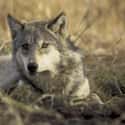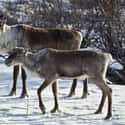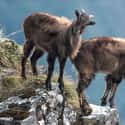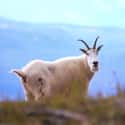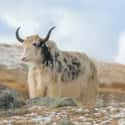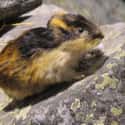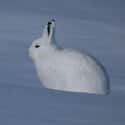-
(#1) Polar Bear
- Ursus maritimus
Polar Bears are arguably the most well-known and beloved animals of the tundra, though you wouldn't want to meet a hungry one. Polar Bears are the largest land carnivores alive on the planet today, and they can weigh in as much as 1,543 lbs., or 700 kg. They have evolved to survive in cold climates, and are adept at hunting across ice and open water.
Polar Bears spend most of their time resting on sea ice, which is clear from their scientific name, Ursus maritimus, which means "maritime bear." They can survive for long periods of time on stored fat but are threatened and classified as "Vulnerable" by the IUCN. Their numbers are dwindling primarily due to habitat loss caused by global climate change.
-
(#2) Penguin
- Spheniscidae
Penguins reside in numerous places around the globe but are predominantly found in Antarctica. There are penguin species that call South Africa, Australia, New Zealand, South America, and southern hemisphere islands, including the Galápagos, home, even though many of these locales are not in tundra biomes. In Antarctica, they reside on the land and surrounding waters of the continent's coasts, where Macaroni, King, Rockhopper, Gentoo, Adelie, Chinstrap, and Emperor penguins can be found.
Penguins are highly social birds that live in large populations consisting of hundreds or thousands of individuals. They are expert hunters in the water, where their bodies have evolved to allow for fast swimming, that looks akin to flight in the air, though all species of penguins are flightless due to their wings use as flippers. Many species are endangered or threatened due primarily to habitat loss caused by global climate change.
-
(#3) Gray Wolf
- Canis lupus
Wolves are one of the most widely distributed and largest species of Canidae, and originally came from North America and Eurasia. These days, wolves are locally extirpated in Western Europe, most of the United States, Mexico, and Japan. Because of their adaptive nature, wolves can live in forests, shrublands, inland wetlands, grasslands, pastures, deserts, rocky peaks of mountains, and tundra.
Wolves thrive in Northern Eurasia and Greenland, where they can avoid human predation, making them a top-tier predator in their local ecosystem. Wolves are able to thrive in cold climates due to their thick fur and thick undercoat that helps keep them warm. They hunt in packs and are known to take down large deer and livestock, which brings them to the attention of ranchers and farmers.
-
(#4) Arctic fox
- Vulpes lagopus
Arctic foxes are a species of small fox found in the Northern Hemisphere's Arctic tundra biome. They are well-adapted to surviving and thriving in cold environments due to their fur, which is thick. Their fur blends in with snow quite well, making for a useful camouflage. They have a generally round body shape, which helps to minimize the escape of body heat, and can live relatively comfortably in temperatures as low as –58°F.
Though the tundra may appear mostly lifeless, there's a lot going on under the snow that people don't typically see. The Arctic fox doesn't have this problem, as it can prey on everything from ringed seal pups and fish to seabirds and lemmings. They have also been known to subsist on carrion, seaweed, and berries. While they are predators in their home environment, they are prey animals to golden eagles, polar bears, other foxes, wolves, and grizzly bears.
-
(#5) Kea
- Nestor notabilis
A Kea is a large parrot found predominantly in the forested and alpine regions of the South Island of New Zealand. While it does live in multiple biomes, the Kea has adapted to live in the arctic tundra of the South Island, making it the only alpine parrot in the world. Sadly, the Kea is listed as "Endangered" by the IUCN, and while it is protected under the Wildlife Act, their numbers diminished for years due to a bounty paid for hunting them.
This was due to their penchant for attacking sheep, but the protections that kicked in by the Wildlife Act in 1986 have helped to raise their numbers. Still, Kea are threatened by introduced predators and insecticides. Kea are incredibly intelligent birds and have been known to solve logical puzzles to obtain food. They are fairly large, measuring in at around 19 inches (48 cm) in length and weighing as much as 2.2 lbs (1 kg).
-
(#6) Migratory Woodland Caribou
- Rangifer tarandus caribou
Caribou, or reindeer in many parts of the world, are large species of deer native to the Arctic and sub-Arctic tundra, boreal, and mountainous regions found in Siberia, North America, and northern Europe. Caribou are threatened and listed as "Vulnerable" by the IUCN, which has tracked herds across the world. The caribou of the contiguous United States was declared functionally extinct after its herd was reduced to only three individuals.
Caribou have evolved to adapt to the weather for optimal metabolic efficiency in the warm and cold months of the year. This is due to their ability to store energy for cold months, which is managed by what they eat and how they burn energy finding and consuming food. They consume lichens for their high concentration of carbohydrates to help achieve this, and the further south they wander, the less lichen they are seen eating.
-
(#7) Snowy Owl
- Bubo scandiacus
The Snowy owl is a large species of owl found in the northern hemisphere. They tend to live and breed primarily in the tundra but can be found in North America and the Palearctic north of Asia. They are one of the largest species of owl and have adapted to living in cold environments. Their plumage is predominantly white, though they do have extensive flecks of dark brown.
Unlike other species of owl, the Snowy owl is active during the day, preferring to hunt at that time. This is especially true during the summer months when it enjoys subsisting on lemmings, though they will eat anything they can, and have been found to subsist on carrion when other sources of food aren't available. The Snowy owl is currently listed as "Threatened" due to a drop in their favorite snack, the lemming. Snowy owl numbers are dependent on the populations of lemmings, so when their numbers drop, so do the owls.
-
(#8) Himalayan Tahr
- Hemitragus jemlahicus
The Himalayan Tahr is a large species of wild goat native to the Himalayas in northern India, southern Tibet, and Nepal. Fortunately, they can survive elsewhere and have been introduced to New Zealand, South Africa, Argentina, and the United States. This is important due to the fact that they are listed as "Near Threatened" by the IUCN. While they aren't considered "Threatened" yet, there is concern that their numbers will begin to fall as global climate change rises.
Himalayan Tahrs are covered in thick, reddish wool coats, which have a thick undercoat, making it easy for the species to survive in harsh cold environments. Their coats begin to thin as winter comes to a close, which helps them adapt as the conditions of their environment become warmer. They can grasp onto sheer mountainous terrain, making it easy for them to avoid predation or capture by humans.
-
(#9) Musk Ox
- Ovibos moschatus
The Muskox (sometimes "musk-ox" or "musk ox") is a species of Bovidae known for its thick coat and strong odor, which is used to attract mates during mating season. They are well known for this smell, but also their unusual look, which the Woods Cree noted in their name for it, which translates into "ugly bison." Muskox can be found in Greenland, Canada, Alaska, and Siberia.
Both the male and females have large, long curved horns ad long, thick fur. Wild muskoxen exist, but the species was domesticated recently. One domestication attempt carried out in the 1950s managed to develop a herd, which is primarily used for meat and wool. Their populations in the wild declined significantly throughout the 20th century due to overheating, though no threats exist for muskoxen in Greenland.
-
(#10) Marmot
- Marmota
Marmots are large ground squirrels found in Asia, Europe, and North America. There are 15 identified species with some living in the Alps, northern Apennines, and Pyrenees mountains. Their preference is a cold and rocky climate, where they make burrowed nests to hibernate in for the winter. The Alpine Marmot is especially fond of cold climates, preferring to nest at heights of 10,500 feet (3,200 m).
They became extinct in the Pyrenees but were successfully reintroduced in 1948, and they continue to thrive there to this day. Due to the climate in which they live, they spend up to nine months out of the year hibernating. When they emerge, they spend most of their time gathering food and eating everything from grasses and herbs to spiders and worms. They aren't fans of warm weather and aren't active very much when the sun is out, even going so far as to forego eating rather than emerge from their burrows on a hot day.
Marmots were in the news in July 2020 after a young boy in Mongolia died after eating one. In doing so, he contracted the Bubonic Plague. Mongolia has recorded nearly 700 cases of Marmot plague between 1928 and 2018. Of those infected, 513 died, leading to a mortality rate of slightly more than 74%
-
(#11) Mountain goat
- Oreamnos americanus
Mountain Goats are a subalpine species of goat found in North America. They are well-known for their ability to cling to sheer rocks in their preferred mountainous terrain. Mountain Goats are predominantly white in color and have significant beards, short tails, and long black horns. Their wooly hide protects them from temperatures as low as −51 °F (−46 °C).
Mountain Goats are the largest animals found in their high-altitude habitats. These can exceed elevations of 13,000 feet (4,000 m), which helps keep them away from predators, though they do sometimes migrate to lower altitudes. While the species has never been domesticated, pre-Columbian Native Americans of the Pacific Northwest Coast incorporated their wool into their weaving. They did this by collecting wool in the Spring, which spared the animals from hunting.
-
(#12) Yak
- Bos grunniens
Many people are familiar with the domestic Yak, but there is a wild, undomesticated variety that is native to the Himalayas. These are the ancestors of the domestic Yak, though they remain extant in their native habitat. Yaks are some of the largest bovids found on the planet, and they can weigh as much as 2,646 lbs. (1,200 kg). They are heavily built with a bulky frame, which makes the domesticated Yak ideal for pulling heavy loads.
Yaks are covered in long shaggy hair, which sits atop a dense wooly undercoat over most of the body. This makes it possible for the Yak to survive the harsh cold temperatures of the Himalayas. Several subspecies, including the Wild Golden Yak of China, is listed as "Endangered" due to only 170 known individuals remaining in the wild. Overall, the wild Yak is listed as "Vulnerable" by the IUCN, which noted its population decline as a result of poaching, interbreeding, and cattle-borne disease.
-
(#13) Pika
- Ochotona
A Pika is a small mammal found in the mountainous cold regions of Asia and North America. They are round in shape, have short rounded ears, no external tail, and closely resemble a small rabbit, which is a cousin of the Pika. The Large-eared Pika resides in the Himalayas at heights of 20,000 feet (6,000 meters), making it one of the highest-living mammals in the world.
The Large-eared Pika can be found in the mountainous regions of Afghanistan, China, India, Kazakhstan, Kyrgyzstan, Nepal, Pakistan, and Tajikistan, where it lives in and around boulders. Their population size remains unknown due to its range and difficult habitat, but these traits ensure its survival, as no known threats exist that could endanger these tiny mammals.
-
(#14) Norway lemming
- Lemmus lemmus
Most people think of lemmings as suicidal rodents, but there is no validity to that widespread myth. Instead, they are small animals from the vole, and muskrat family found predominantly near Arctic tundra biomes. They are relatively small, measuring around six inches (15.5cm) in length, and weighing only around 0.8 - 1.2 oz (23 - 34 g).
Lemmings remain active during the harsh winter, where they burrow through the snow, creating large tunnel systems. This often protects them from predators, but they are a favorite snack of the Arctic fox and many other predators that call the tundra home. They are herbivorous, and subsist primarily on lichens and grasses, but have been known to forage for berries, leaves, bulbs, and roots deep in the snow.
-
(#15) Arctic Hare
- Lepus arcticus
The Arctic hare is a species of hare that has completely adapted to live and prosper int he Arctic tundra. They are found in North America, Greenland, and the Arctic, where they typically live at elevations between sea level and 900 m. Unlike its southern cousins, the Arctic hare has short ears and a small nose, which helps in preventing heat loss.
Additionally, their bodies are approximately 20% fat, and their fur is thick, which helps to keep them warm. They dig holes in the snow to sleep and keep warm while avoiding predators. Often, they travel in small packs, which can include up to 80+ individuals that huddle together for warmth, though they are most often found alone. The Arctic hare is well-adapted to its environment, and it has the ability to run at a shockingly fast 40 mph (60 kph).
New Random Displays Display All By Ranking
About This Tool
The most representative tundra animals include arctic hares, thunderbirds, polar bears, and grizzly bears, etc. Animals that thrive in the tundra must evolve over time to adapt to the harsh climate and living conditions. The feature of the entire tundra is that there is a permafrost layer under the soil. This cold and humid environment causes physiological drought of plants and a lack of animal diversity.
Tundra is one of the coldest and arid regions in the world, but many very cool and unique animals live in the cold tundra which have evolved unique skills to adapt to survival and hunting. The random tool introduced the 15 coolest animals that live in the tundra.
Our data comes from Ranker, If you want to participate in the ranking of items displayed on this page, please click here.












